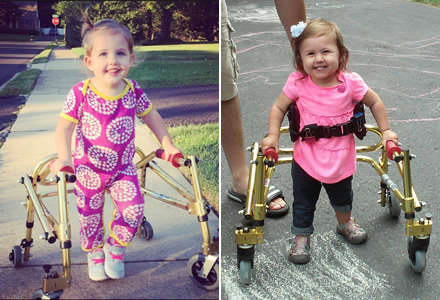
Our Story
"Cure SPG47" was initially founded in 2016 by the families of two newly diagnosed SPG47 patients, Molly and Robbie. At the time when these two families serendipitously met on Facebook, we were aware of just 9 additional documented cases of SPG47 worldwide. No research was being conducted on the disorder and no treatment options were being explored. The chance connection of these two motivated families lead to the forming of a 501(c)3 non-profit organization dedicated to raising funds and awareness about the disorder. As we learned more about the disorder and built an impressive scientific team, we decided to expand our non-profit mission to include all four of the AP-4 Adaptor Complex related sub-types of Hereditary Spastic Paraplegia (SPG47, SPG50, SPG51 and SPG52). We are eager to find out what we can accomplish with a larger number of families pulling in the same direction!
Coming to terms with an AP-4 HSP diagnosis for our children has been particularly difficult. Realistically, we understand that many researchers, donors, and drug makers will choose to focus their efforts on more mainstream diseases with larger patient populations. Yet the clock is ticking rapidly for our families, and without intervention, these disorders are expected to progress towards paraplegia or quadriplegia, with irreparable cognitive impairment, over the coming years. Despite the odds, we refuse to accept the prognosis or to give up on our children.
While our children struggle with mobility and fall behind their peers verbally, they THRIVE when it comes to personality and perseverance. Joyful smiles come so easily to them. Their lack of frustration at their communication and physical limitations is truly remarkable. Each milestone is celebrated exuberantly, even while we live in fear each day that muscle spasticity will worsen or a seizure will cause more brain damage.
We are driven to raise funds to direct towards the most promising scientific research. Our goal is to tip the odds in favor of all AP-4 HSP patients, giving them a chance at a high quality of life which will not be attainable without intervention through revolutionary treatments.
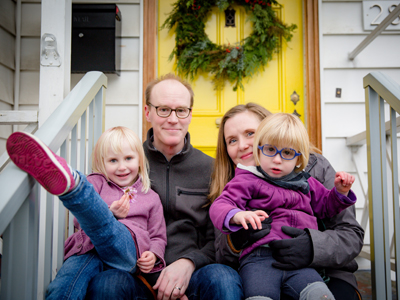
The Anderson Family
We live in Seattle. Emmy is a stay-at-home home children's librarian. Kirk is a creative director and a musician. Our eldest, Hazel June is a creative, bike-riding, amazing big sister. Wren is an inquisitive social butterfly. She relishes silly sounds, music, being tickled, and trying to keep up with Hazel. As a family, we love to travel, be outside on our bicycles, work in our garden, and have dance parties in the kitchen. It has been wonderful to learn about these other amazing little ones who share this diagnosis. We look forward to helping increase awareness and research on SPG47, not just for the kids on this page, but for the ones we have yet to meet.
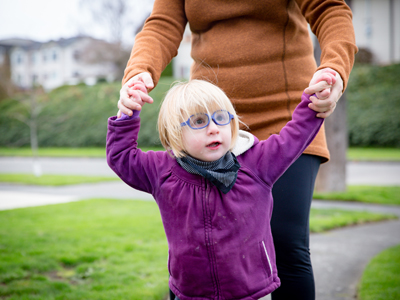
Meet Wren
Born in our home, we welcomed Wren into our family, with love. She had a sweet, typical newborn period. By the time she was four months we noticed developmental differences and she started early intervention services at seven months. Around the same time she had a febrile seizure with complications that required a stay in the ICU at Seattle Children's Hospital. An MRI revealed delayed myelination and an arachnoid cyst. She was given an initial diagnosis of global developmental delay and hypotonia, but the assumption was that there was an underlying genetic condition that was causing her delays and "low tone". We followed up with an array of specialists and began our diagnosis journey. After several years of increasingly advanced genetic testing, we received the diagnosis of SPG47 in December 2016.
Throughout this time, Wren continued to grow and learn at a slow, but steady pace. She is a friendly, curious, and determined child. She enjoys exploring her world with her signature sassy crawl, or with the assistance of her gait trainer. She has a deep connection with animals. Music, food, and laughter bring her great joy. She is our wonder girl and she has completed our family.
Click here to donate towards research that could directly impact Wren.
The Cavaca Family
Family of 3, André, Isabel and Francisco, we are from Portugal. André was born in April 2015 and spent the first days of his life in the NICU with some feeding difficulties. After that he gained almost no weight and his levels of ammonia were high and the levels of some amino acids were off too. Doctors thought it was a metabolic disease and he started a hypoproteic diet and doing all kind of tests and monitoring and started early intervention with several therapies.
As he was growing up and skipping all the milestones and the metabolic and some genetic testing coming all normal, the testing our national health service provides was not enough, so we decided to try to get some help outside our country. The MRI showed delayed myelination, polymycrogyria, corpus callosum dysgenesis and dysmorphic ventricules and some epileptic seizures occurred.
We needed to know what was causing all the delays and all the abnormalities in his brain. We contacted about 20 researchers worldwide and one amazing Portuguese researcher working abroad helped us and did all the genetic testing we needed to get the diagnosis: a very rare mutation in AP4S1 gene, associated with Spastic Paraplegia type 52. Almost no research was done on this disease, and we were (and still are) the only family in our country with this disease, with only 10 diagnoses made worldwide until then. Being a neurodegenerative disease the news were devastating, but positive as we are, we now know what to anticipate, redirect the therapies, adjust the medication, and have a better focus.
In one of the many sleepless nights researching, we found CureSPG47 and some great families with other AP4-related SPGs, very similar to ours and 3 families with SPG52. Spread out in the world we found our tribe, we found people who have the same will to fight for a cure for this disease and some amazing researchers in Boston Children Hospital what are working on it, so nothing will stop us!
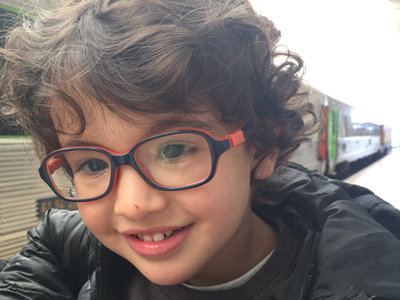
Meet André
André is a hero. His superhero name is #superboy. He wakes up in the morning with the biggest smile and brightens our day, every single day. No matter what is as to do (and he does a lot!), all the tough therapies, exams, doctor appointments, he perseveres. He as an inhuman resilience (did we mention that he is a superhero?), a strong will that never ceases to amaze us. With one single "Olá" - Hello - he melts everyone's hearts, even if someone had a very rough day. SPG52 doesn't define him. He is the sweetest, happy, kind, giggly boy. Did we mention that he is a superhero? ;)
Click here to donate towards research that could directly impact André.
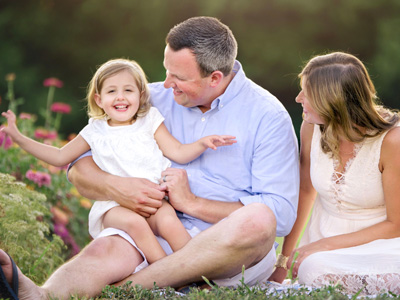
The Duffy Family
Molly has always had low muscle tone. She spent the first 14 days of her life in the NICU for various reasons, one of which was how "floppy" she was. She was eventually diagnosed with apnea and reflux and after two unexpected weeks of testing and monitoring, we happily took our newborn home. Little did we know, this was just the beginning of the unknowns.
Molly continued to exhibit weakness as she grew and as a result started receiving physical therapy at our home once a week, starting at 4 months old. Again, we thought this was something that she would outgrow and just be temporary. As the months went on, the amount of PT increased and other therapies were introduced including occupation therapy, speech therapy, a special instructor and hippotherapy.
Not having an answer or diagnosis, we turned to a neurologist who initially diagnosed Molly with Benign Congenital Hypotonia; a general diagnosis given when the underlying cause of the low muscle tone is still unknown. We always questioned if there was in fact an underlying cause and also wanted a more accurate diagnosis, so in March of 2015, we opted for genetic testing. The first test that was done was the Genome Wide Array, which tested Molly's chromosomes. This testing did not find anything, which was a big relief for us, but still left us with questions. We decided to move forward with the next level of testing called Whole Exome Sequencing. This testing was much more in depth and took 6 months to come back. When we finally got the results, after what seemed like an eternity, we were told that the diagnosis they were leaning towards was Hereditary Spastic Paraplegia, Type 47. Leaving the appointment, after hearing the news, we were obviously devastated. One of the hardest parts has been the lack of research on this disease. When you are given information based off of very few people, it is very hard to label Molly the same way, especially when some similarities lack.
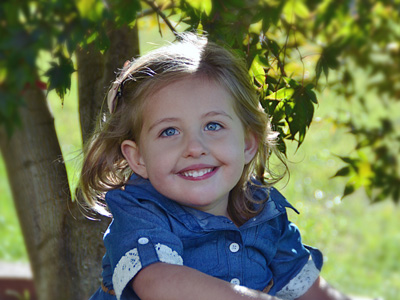
Meet Molly
Molly is one of the sweetest and happiest children that you will ever meet! Even with all that she has going on, she exudes happiness and shares her smile with everyone she interacts with; one of the traits that she is always complimented on.
There was a day shortly after receiving Molly's diagnosis that we were sitting at home upset and feeling helpless. We looked over at Molly and she did just what she always does - gave us a huge smile which brought us right back to reality. There we were consumed with sadness and she was sitting right next to us with no idea that anything was wrong. She was just living her life the only way she knows how - happily! It was that moment that changed our entire perception of this new journey we were on. We decided that moving forward, our focus of each day would be joy and happiness because Molly gives that to everyone she meets.
As hard as this has been, we just keep looking at our strong and determined little girl and know she will not let anything get in her way of achieving anything she wants. While our life may look a little different than others, we have been blessed with one beautiful and happy little girl!
Click here to donate towards research that could directly impact Molly.
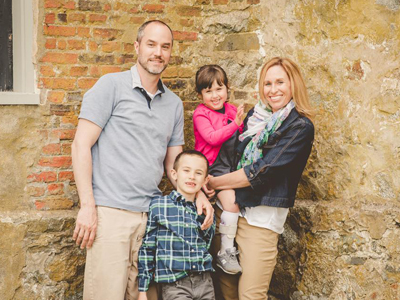
The Edwards Family
In July, 2015, when our daughter, Robbie, was not reaching the milestones that came so easily to her brother and peers, we took the initiative to have her assessed by a team of medical professionals to try to get to the root of her delays. Due to her mild microcephaly, Robbie's neurologist suggested an MRI. We agreed, being certain that the more knowledge we have, the better our chance to intervene with therapies. Her MRI was set for August.
Near the end of July, Robbie suffered a prolonged absence seizure while on vacation in Cape Cod. A medivac flight took Robbie and myself to Boston Children's Hospital, where Chris was anxiously awaiting our arrival. While there, it was considered a reasonable request to expedite her MRI. The results, a thin corpus callosum, and decreased myelination of white brain matter, eventually led to the suggestion that her brain abnormalities were likely due to a genetic cause. Again, we knew we needed answers. For myself, I felt assured that whatever came up would likely bring relief. I believed that whatever damage had been done to her brain prenatally was the worst of it and it would just be progress from there on out. Chris needed to know what battle we were fighting in order to best arm ourselves against it. Neither of us was prepared for the diagnosis Robbie was given.
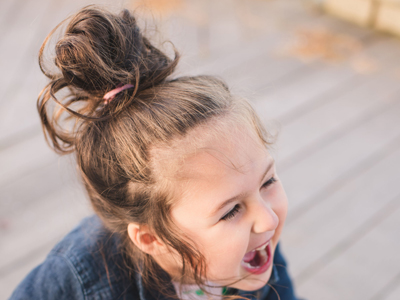
Meet Robbie
» Robbie's Cheering Section: Facebook
"She is just so sweet." "I never see her upset." "She is always so happy and has the best smile." These are not our
words, but the phrases we hear so often about our daughter. Robbie adores people, mischief, and a good laugh. Her laugh
is one of the best. Robbie is genuinely one of the kindest souls I've met. Though almost three years old, I have never
witnessed her cry or get upset when a child takes a toy out of her hands. In fact, when asked, she will happily hand you
anything she has, even if it is a coveted cookie that she has been eagerly anticipating eating. She is purely a
benevolent child. She has been globally developmentally delayed since birth and every milestone is cherished. But there
is one that she accomplished at 5 months that will always stand out in my mind. This was the first time she ever kissed
me. With a wide-mouthed, wet kiss on the side of the cheek, she made her intentions clear. She didn't just kiss me
once- she kissed me over and over again, enveloping me with love. And she has never stopped since.
Click here to donate towards research that could directly impact Robbie.
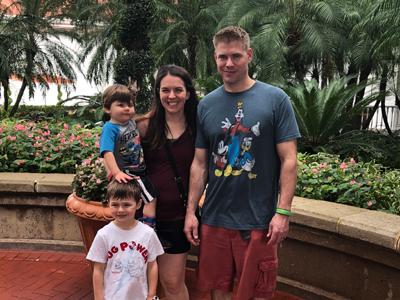
The Fick Family
From Western New York, where Mike (dad) works in the city that smells like Cheerios, Carrie (mom) writes about toys, and our two boys keep us going non-stop!
When Dante, our youngest, was around 10 months old we noticed he wasn't reaching milestones. Even though people told us all babies are different, we knew something wasn't right. By Dante's first birthday, he still could not pull himself up into a seated position and if we sat him down he would usually fall right over. His crawl was an army crawl and he couldn't lift his body off the floor.
The red flags for his doctor were between 12 and 15 months when she saw Dante didn't grow. Our chubby cheeked baby hadn't put on much weight, was the same height, and his head size was the same. So the list of specialist visits started.
Our first neurologist appointment was overwhelming to say the least. For two parents who had no clue what was going on with their baby, we left with more questions than answers. That was the longest car ride home. My husband and I not talking and just crying the whole way.
Not long after in March 2017, Dante had his first febrile seizure. Not knowing that's what it was, Mike called 911 to report an allergic reaction to something Dante ate. The paramedics arrived and gave him an epi pen and then Dante started seizing. He was taken to Children's Hospital by ambulance where he continued seizing for two hours before they could get him to stop. MRIs, scans, blood work and days in the PICU came up with everything from trauma that could have happened when I was pregnant to fluid in his brain and then the diagnosis of febrile seizure.
We followed up with neurology, neuro surgery, endocrinology, and more specialists before heading to UR Medicine to get another neurology opinion. Dante saw a neuro geneticist and we were sent immediately for genetic testing. By August 2017 we had our diagnosis a mutation of the AP4S1 gene with SPG52.
To say we were relieved to have answers about what was causing everything is an understatement. Finally we knew the reason for the global delays, high tone, seizures, microcephaly, strabismus ... it all made sense!
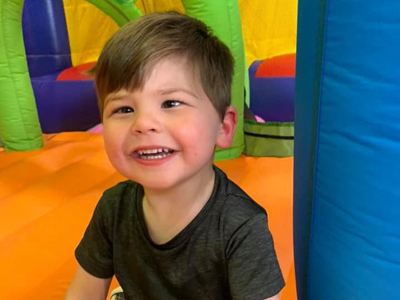
Meet Dante
The name Dante means enduring and we couldn't have picked a better name for this guy without even knowing what he'd have to go through.
He has been in early intervention since he was 15 months old, and is currently attending full day preschool at a special needs school where he also receives all his support services. He has a packed schedule which includes physical therapy, speech therapy, occupational therapy and vision therapy - on top of class work and playing with friends.
At 3 1/2 years old, Dante is still unable to stand or walk independently. He wears AFOs and uses a posture walker or crawls to get around. He can use a combo of sign language and some verbal words, but his vocabulary is still limited. Despite all the worry we have for his future, he brings us joy every day with his smile and amazing belly laugh.
Click here to donate towards research that could directly impact Dante.
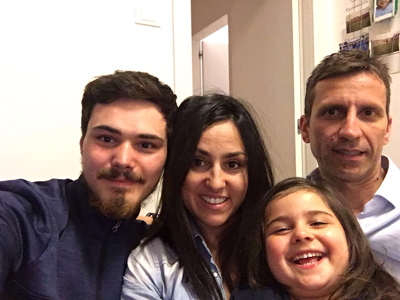
The Fipponi Family
The serenity that you would expect to live while pregnant did not last long for us. Since the first morphology ultrasound, doctors noticed a dilatation of the left cerebral ventricle in Sofia's brain. For the rest of the pregnancy, we were constantly undergoing fetal ultrasound controls and even a fetal MRI. Nonetheless, almost every doctor seemed to want to reassure us. When Sofia was born, we thought that the nightmare of exams was over. She was simply wonderful. When she was three months old, we noticed that she still didn't hold on to objects. As months passed, the situation did not change, until we were sent to a rehabilitation centre. There, they would had helped our Sofia, a child that every specialist considered only very lazy. But the more time passed, the more our fears were confirmed. The first part of our journey had already started: to find a diagnosis and a better therapy. It has been five years of internet researches, visits, and fears. Furthermore, five years of dramatic medical hypothesizes of diseases only to be proven wrong by analysis results. However, we have not stopped our research and here we are today, with a diagnosis at last: SPG47. Now we know what we are fighting against. A new journey has begun, now we are searching for a cure. And we are no longer alone in this journey. I will not say that our life is easy, but it has never been so full of love and awareness until now. Together, hand in hand, we are living this great love.

Meet Sophia
She is a very special girl who has overflown our souls with love. Whoever stops to look at her gets captured by her big dark eyes and by her amazing ability to communicate without words. Joyful and unaware of her limits, she loves to listen to music and dance. If it were for her, we would spend days singing her songs. She laughs, she laughs throwing her head backwards, she laughs until she has no more breath left, she laughs and people can't help but laugh with her.
Every single day she works hard to reach her goals, ordinary for most, but Olympic medals for her and us. Sofia doesn't know what disability is, she doesn't look sadly at other children, because she doesn't see what's missing. She sees what there is and what she wants to have...especially when it comes to cookies and chocolate. Here too, she teaches us an important lesson. She has raised our gaze from the ground to show us that the rainbow resides in the most unexpected places, in the little things. We have given her life, and she has taught us how to breathe, to breathe a life of unconditional love.
Click here to donate towards research that could directly impact Sophia.
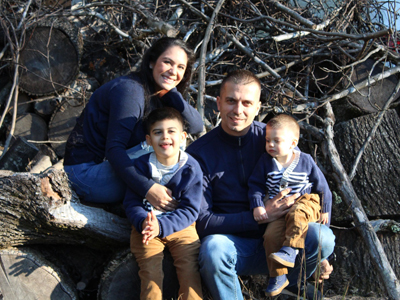
The Mustafa Family
We are a mixed family, residing in Atlanta, Georgia. Mom Alondra is from Mexico, dad Tony is from Albania, and Arian
and Florian are a mixture of both. Both Arian whom is 7 years of age and Florian whom is 2 years old, are affected by
SPG52.
Our story begins in utero, when mom and dad went to their 20 week OBGYN visit to find out the sex of their first born
Arian. During the ultrasound, we noticed that the nurse was continuously looking over Arian's brain. After bringing in the
doctor, it was explained that there were some abnormalities with the baby's brain and we needed to see a specialist to get
a better look. After visiting the fetal specialist, we were given the option to abort due to excess liquid in the brain
ventricles also known as ventricularmegaly, which could cause developmental delays in our son after birth. We declined the
offer and accepted God's will, and that is where our beautiful story begins...
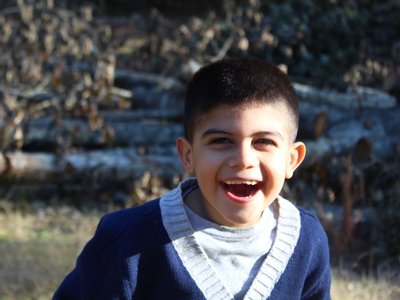
Meet Arian
Since we were aware that Arian would be special before his arrival, we kept a watchful eye on his developmental milestones as he grew. Mom's educational background as a special education teacher and early interventionists was of great help in getting him his therapies in place early on. Arian was very chubby as a baby and did not move nor cry much. We considered him to be a lazy baby and noticed around 7 months that his legs were overly loose. His toes could touch the chins of his legs and he still did not sit up. When propped up he would slide down resembling a rag doll. Arian began early intervention services at 9 months of age with physical therapy initially and speech and occupational therapy added 6 months later. Arian began OT due to his hands remaining fisted and speech was added due to his lack of emotion, sounds, words, and occasionally choking during meals. As Arian developed, we noticed the therapies were really helping him. At 12 months of age he sat up independently and began to say "mama" and "baba". His hands opened up slowly and we began to show him how to play with toys through play therapy. We thought we were home free and our little boy was going to be alright, until at 16 months of age he suffered his first seizure.
Arian's seizures are very intense and scary. He does not convulse and is unresponsive. He has complex partial seizures that typically last from 30 minutes to 1 hour and a half and are brought on by fever or sickness. All of his seizures have required an intensive care unit or ICU stay in the hospital, typically lasting 3 days due to having to be intubated upon arrival. Due to Arian's seizures occurring as he is falling asleep, asleep, or as he is waking up. We continue to co-sleep and struggle with letting him sleep alone, in fear that he may pass away.
Aside from his seizures, Arian also has vision problems and is considered to function at the level of blindness. He has a medical diagnosis of cerebral visual impairment also known as CVI. As a baby he had esotropia and underwent strabismus eye surgery on both eyes at the age of 3 years.
Arian has also undergone bilateral hip rotation and leg surgery at the age of 6 years of age, due to hip dysplasia caused by the tightening of his leg muscles as the hypertonia or muscle tightening progresses. Due to Arian resembling cerebral palsy patients, he was previously misdiagnosed with CP before SPG52. He received his SPG52 diagnosis in June 2017 at 5 ½ years of age after whole exome sequencing genetic testing. He currently moves with help from a wheelchair and posterior walker and says less than 10 words. He receives PT, OT, Speech, vision therapy, play therapy, hippotherapy, and aqua therapy privately and through his special education classroom weekly.
Arian is a very silly boy and has fun sharing a good laugh with others. He is a great helper and enjoys cooking and cleaning for fun! He has recently learned to flirt with older girls using his AAC device and loves playing with his baby brother Florian!
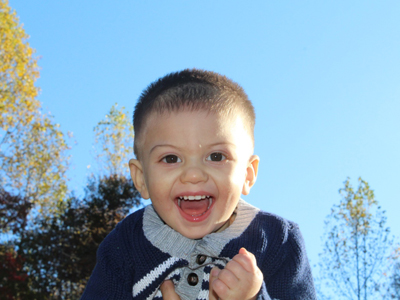
Meet Florian
After years of being reassured that Florian's older brother's condition was an anomaly, we decided to have our second child. As Florian developed in utero and was followed closely by fetal specialists due to our history, we were dismissed as patients due to intact 3D baby ultrasounds and testing reassuring us that our son would be healthy.
At 6 months of age, we were advised to do targeted genetic testing by his older brother's geneticist; at the time we had no concerns over Florian's development. Two days after Christmas of 2018 and 4 days after Florian's 1st birthday we discovered that Florian also had SPG52.
Doctors consider Florian to have a less complex form of SPG52 to that of his older brother. Florian has no vision impairments and no seizures currently. Florian still shares diagnosis' of microcephaly and significant developmental delay in all areas of development including adaptive, social emotional, communication, gross and fine motor, and cognitive skills.
Florian has been actively receiving early intervention services since 9 months of age. He began with occupational therapy due to abnormal sensory seeking behaviors and physical therapy added by 12 months due to him being unable to sit independently. Speech was added at a year and a half due to lack of sounds/words and a failure to thrive diagnosis because of his facial hypotonia or his face muscles getting tired too quickly while eating. Florian currently receives PT, OT, Speech, play therapy, and aqua therapy weekly. He currently moves around by crawling and cruising and says "ball".
Florian is a very happy boy and is constantly greeting friends with waves. He is daring and fearless! He enjoys being thrown in the air and swinging high in the sky. He loves water and is easily convinced by his older brother Arian to get into little boy trouble!
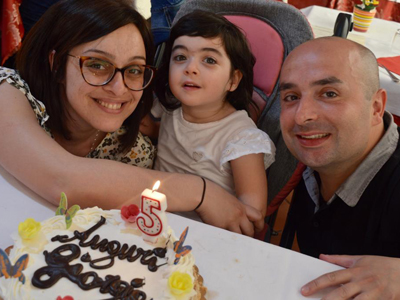
The Nassi Family
Giorgia's story started, as usual, with a young woman and a young man who wanted to build up a family. Giorgia came into our lives one day at the end of May, as usual, between pain and cries, but when our eyes met we realized we wouldn't be able to live without her. A beautyful baby, perfect at first sight, with a flame shaped angyoma on the forehead and partly on the left eyelid, now almost disappeared. She was little, too little and so remained for a long long time. Soon I understood something was going wrong, even if I refused to get bad thoughts into my mind. But very soon those thougths turned in reality. Only few months were gone and Giorgia wasn't growing enough, showed difficulty in milk swallowing, she never cried and slept too much. There was some problem indeed! Weeks went by and she wasn't able to catch objects, to sit properly - actions a baby had to do as usual - but the worst thing was the incompetence of her first pediatrician. Her head and her chest weren't growing as well, but we didn't know it at all. However there was a beahviour that was misleading us: Giorgia smiled all the time, as if she felt always happy. So, I spent my days waiting for some improvement to appear, a jump forward in her growth, but in my mind I was afraid it would never come. In fact, time went by and Giorgia wasn't able to learn anything, she seemed to have stopped at the day of her birth. Then, we had the first visit with the child neuropsychiatrist, and Giorgi was 11 months old when she started her psychomotor route. Few weeks later we had the first genetic examination. They suspected a rare syndrome, not saying its name, but I soon discovered it: Cornelia De Lange Syndrome. But this one, as others, was rejected after the results of the first genetic tests arrived after several months. We were still hoping it were only a nightmare and that Giorgia would soon start to say "mum" or "dad" and to stand and walk alone. We still hoped practitioners and my fears were wrong. But wasn't so and that hope faded at her first birthday when she had her first seizures. She started to open her arms with jerky movements. The electroencephalogram confirmed the existence of a mild form of epilexia, so a pharmacologic treatment of the condition started without prompt improving. At that time the staff of Meyer Child Hospital in Florence took in charge Giorgia for epilexia and goes on following her at present. We are grateful to Dr. B, who fought so much for Giorgia, mainly when we stopped to believe those crisis wouldn't ever be over. Meanwhile the crisis changed their pattern: apart the jerky movement of her arms diffuse tremors appeared. Dr. B continued to search the right drug, and she find it at end and seizures disappeared after one year. Afterwards NMR confirmed a microencephalia, a brain malformation with agenesis of corpus callosum and were performed several genetic tests which after almost three years led to a diagnosis. We always wonder why the legs of Giorgia were constantly stiff and have equine feet. It wasn't a true spasticity because the stiffness resolved when she sat down or flexing her legs; her feet then softened and no more stiff as when she extended her legs. She cannot still stand at present, but she learned to crawl on gound. When the genetic test ended and the diagnosis arrived we had an answer to all our doubts and all our questions. Giorgia is affected by a extremely rare - type 52 - spastic paraplegya. A neurodegenrative condition that leads to a psychomotor delay, partial or total speaking ability, epilexia and paraplegia with a progressive stiffening of the legs. This situation disrupts our lifes, robs us of our sleeps, and forces us to live in a way we would never wanted, but now the most important thing is seeing the great improvements Giorgia has done day by day. Others will come. In the "Stella Maris" Center - nearby Pisa - we met excellent pediatricians who will follow us in this hard trek. Giorgia today is five years old and as I wrote cannot standing but crawls and tries to stand up. She can catch objects and also if she uses to play her way sometimes she behaves quite oddly it's fantastic to see her doing all these things! She does several therapies, psychomotricity, acquaticity, logopedy and physiotherapy. Some week ago she said, for the first time, "mom"! And she use to say it all day long and how she's happy in doing it. Even if she doesn't speak she communicates very well. Often we wonder why this has happened to us, why we cannot be a family as other are, why we cannot think to have another baby, why the story of Giorgia cannot be as the majority of other ones. But then we realize the story of Giorgia is wonderful this way, and we have and will have sad moments and tears but happyness and smiles as well!
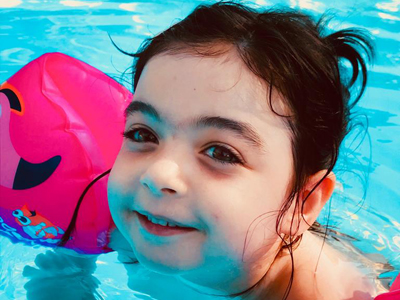
Click here to donate towards research that could directly impact Giorgia.
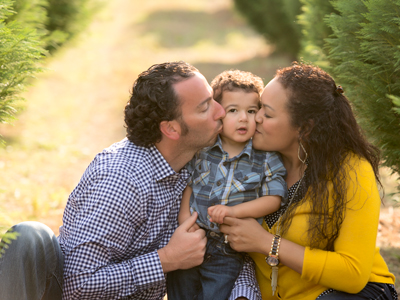
The Rosenberg Family
Ethan had a traumatic entry into this world (shoulder dystocia, nuchal cord, low sugar levels, and periodic breathing), but after 4 ½ days in the NICU, in addition to a prominent cephalohematoma, we believed we were taking home a perfectly healthy baby boy. At his 2-month and 4-month follow-ups, he missed milestones and was referred for occupational therapy. Over time, we slowly started to notice him struggling to do things as simple as holding his arms out to grab something. At 10-months, Ethan started experiencing breath-holding spells, which resulted in several visits to the E.R. At the second visit, they recommended doing an MRI due to his spells and global developmental delays. The results evidenced a cerebellar brain bleed, a mildly diffused corpus callosum, and decreased periventricular white matter. We were told at this point he just needed more aggressive therapy, so we added speech and physical therapies to his weekly routine. Six months later, we decided to see a developmental pediatrician because he was not progressing the way everyone anticipated. This eventually led to an autism diagnosis at 22-months old, as well as an additional therapy called Applied Behavior Analysis (ABA). During this time, we started to wonder if there was something genetically abnormal with Ethan, and it was in April 2016, while on Facebook we came across a research program at Columbia University, that was doing a study of the SLC1A4 gene and the link between an Ashkenazi Jewish parent (Dad) and microcephaly. Since Ethan also had microcephaly, we decided to do the whole exome sequencing exam offered through their program, but did not have any concerns of a genetic condition since his doctors did not feel one was present. 2 ½ months later (one day before Hanukkah and two days before Christmas), we got a call from the Lead Researcher, who shared the news that Ethan was diagnosed with an ultra-rare genetic neurological brain disorder, called Hereditary Spastic Paraplegia Type 47 (SPG47).
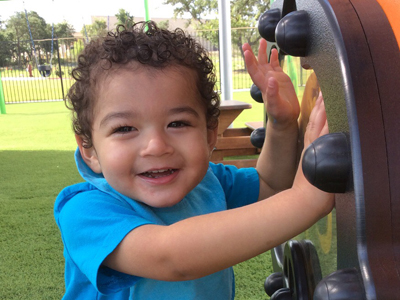
Meet Ethan
When people meet Ethan, the consensus is he looks like the happiest little boy ever. Although Ethan was delayed with smiles and laughter, and we had to work so hard for each one, today his smiles and laughter comes so easily and he does it at every opportunity. Even when you say the word "smile", his face just lights up with the biggest grin that can melt anyone's heart. He struggles with being non-verbal and can get frustrated not being able to convey his wants and feelings, but most of the time he just loves and loves to be loved. One of his favorite things to do is give "raspberries". Even if it's on his own arms, it just tickles him to pieces. Also, the first thing he does when you hold him is put his head on your shoulders to give you a hug. He just adores giving hugs and kisses on the lips if you say, "Can I have a hug?" and "Mommy/Daddy want a kiss". Despite our fears of what this disease will do to Ethan physically, our greatest fear is losing Ethan's sweet personality and all the simple things in life that bring such joy to his everyday world. We will continue to fight for him and the future he and the other SPG47 kids deserve!
Click here to donate towards research that could directly impact Ethan.
